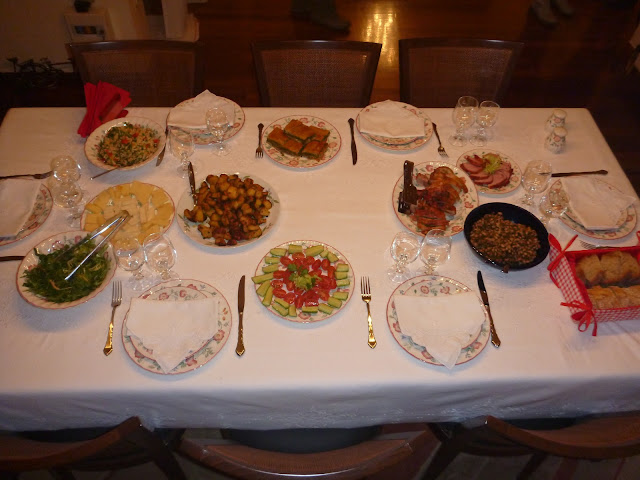If you have been faithfully keeping up with our blog, you know that Ken bought a small bouzouki-like instrument called a "baglama," which has the advantage of being easy to carry to and from his music lessons.
He hasn't yet given up on the mandolin, either, which he brought with us to Greece. Greeks LOVE the fact that he wants to learn "old style" Greek folk music. It's called "rebetiko" or "rembetiko" and some aspects of its history are similar to the birth of the "blues." (In some ways, rebetiko is comparable to the "old timey" American music with which Ken most closely identifies as a musician--i.e. not the prettified tunes that make their way into the commercial mainstream, but rather more "down home" music. There's even the similarity that both experienced a "folk revival" among younger musicians during the 1960s and 1970s.)
We found out only today, however, that it is insulting to refer to a person as a baglama. (It's like saying, "he's a dumb oaf.")
Meanwhile, here's Ken trying out his Greek music chops (on the mandolin--the baglama isn't ready for prime time) with a very serious and accomplished musician (the guy in drag). This happened to be the day in anticipation of Easter--somewhat like Mardi Gras--that Greeks dress up in costumes.
This event was in a taverna full of people who had come to celebrate the day and listen to the music. Greeks don't consider that a reason to stop talking or eating, however. The most important thing, our host explained, is what happens between people. The music is there to be enjoyed, but not to the extent of treating it like a performance--except that people do applaud at the end of each number, while also still talking, eating, and drinking.
And here's live action of that day. Ken is gamely trying to keep up with a tune he's never heard before by watching the fingering of the guitarist next to him and "translating" that to what he needs to play on the mandolin.
He hasn't yet given up on the mandolin, either, which he brought with us to Greece. Greeks LOVE the fact that he wants to learn "old style" Greek folk music. It's called "rebetiko" or "rembetiko" and some aspects of its history are similar to the birth of the "blues." (In some ways, rebetiko is comparable to the "old timey" American music with which Ken most closely identifies as a musician--i.e. not the prettified tunes that make their way into the commercial mainstream, but rather more "down home" music. There's even the similarity that both experienced a "folk revival" among younger musicians during the 1960s and 1970s.)
We found out only today, however, that it is insulting to refer to a person as a baglama. (It's like saying, "he's a dumb oaf.")
Meanwhile, here's Ken trying out his Greek music chops (on the mandolin--the baglama isn't ready for prime time) with a very serious and accomplished musician (the guy in drag). This happened to be the day in anticipation of Easter--somewhat like Mardi Gras--that Greeks dress up in costumes.
This event was in a taverna full of people who had come to celebrate the day and listen to the music. Greeks don't consider that a reason to stop talking or eating, however. The most important thing, our host explained, is what happens between people. The music is there to be enjoyed, but not to the extent of treating it like a performance--except that people do applaud at the end of each number, while also still talking, eating, and drinking.
 |
| The person in the middle is a woman (and the major singer of the group) Not everyone cross-dresses--we also saw pirates, bunnies, hobos, etc. |













































